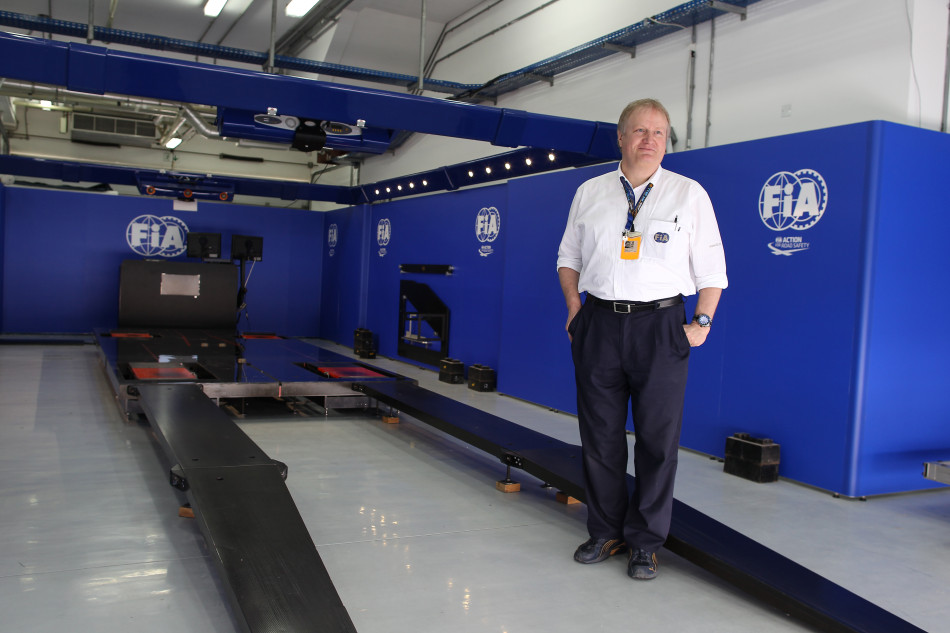The Watchmen Part 1: New Rules, New Challenges

The final moments of Formula One Grands Prix are, on the surface, fairly chaotic. As the chequered flag falls, team members flood the pit wall to wave home winners. The victorious swoop towards them in acknowledgement of a job well done, podium finishers pump the air in celebration, and everyone begins to get ready for the joy of the podium celebrations.
However, look past the champagne spray and adrenaline-fuelled chest bumping and in the midst of the chaos in pit lane, organisation is once again taking hold. Up and down parc fermé, a small crew of officials checks each car, making sure they’re safe. Car data is then downloaded for analysis, all of which must be done before the final result is published.
It’s not just in the heated moments after the flag falls that these careful checks take place, either. From the moment the cars arrive at each grand prix circuit, the FIA’s technical crew is on alert, steadily working through a series of tests to ensure that each car conforms to F1’s regulations – making sure the playing field is level. A small coterie up against the ingenuity and brain power of thousands of the brightest minds in motor sport, all of whom are seeking to push the rules as far as possible in pursuit of the infinitesimal time advantages which define victory in Formula One. It’s a hugely demanding task, but one that in 2014 has become even more complex.
This 2014 season sees the sport undergoing the biggest regulation change in its 60-year history. The arrival of a new V6, 1.6-litre turbocharged hybrid power unit featuring extensive energy recovery systems means the FIA technical team is dealing with a radically different F1 landscape.
“It’s a different world, it has nothing to do with the old cars,” says technical delegate Jo Bauer, who heads up the 10-man team that reports to race director Charlie Whiting. “The whole area we are involved in is completely different. We learned a lot through [pre-season] testing, and we need to be organised just to get through it. It’s going to be difficult and time-consuming this year, but we are prepared.”

The shape of grand prix weekends has largely been fixed in recent years, with the main body of the technical crew setting up at a circuit on the Wednesday before the race (Tuesday in the case of long-haul events and Monaco) and the software analysis team setting up a day later. The FIA technical area is established in the pitlane garages, with a measuring platform installed, the trucks that are home to the technical crew for the weekend are readied and the fuel-testing laboratory is set up.
“On Wednesday, everything has to be operational by lunchtime,” explains Bauer. “The teams then have the choice to come to us and do private deflection tests [in which car elements are tested to check they meet tolerances] or any measurement checks they would like to do, but they have to book this in advance.
“Then, on Thursday at 8.30am, we are at the track for initial scrutineering. We brief the scrutineers and the platform crew, and then start at 10am. This is largely to check that all the cars meet our safety requirements.
“Every country provides 30 scrutineers and we split those into a platform crew, tyre checkers and garage scrutineers. Each car is scrutinised and this has to be done before 4pm when we submit a report to the stewards who then publish the entry list.”
A weekend of old would then involve the technical team working steadily through a regime of checks. These would include testing fuel samples from the teams before and after each track session, logging engine use, inspecting seals on components the teams were not permitted to interfere with – such as gearboxes and engine control units – checking tyres and doing software checks on car systems. The work would go on throughout the weekend.
But while the methodology remains the same for 2014 – “we carry out regular checks on all aspects of the cars during the weekend,” says Bauer – the shape of the technical team’s workload has changed dramatically.”

 Facebook
Facebook Twitter
Twitter






